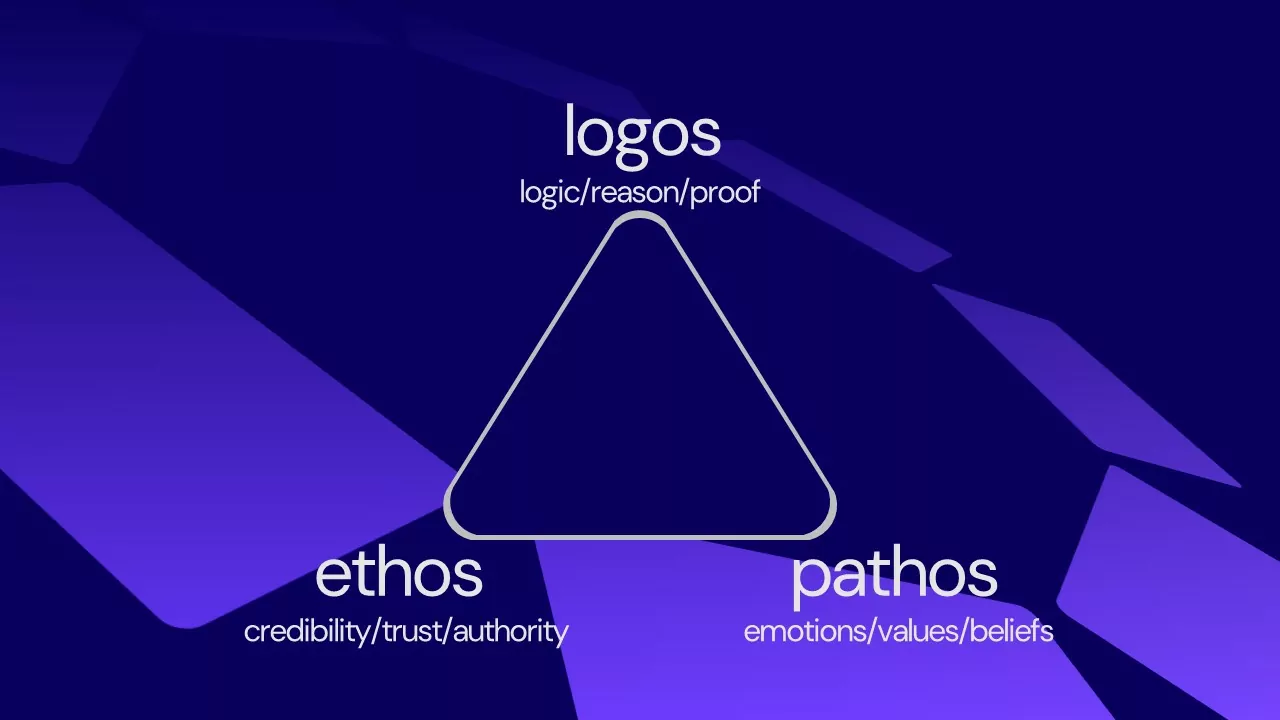Ethos, Logos, Pathos, What Now?
Conquering your audience: Aristotle’s secrets and the art of persuasion
How do we make all of our arguments the absolute goodest they can be? You need to brush up on your Aristotle. The (great-great-great, etc.) grandfather of arguments, and founder of the trifecta of key ingredients for winning any debate: ethos, logos and pathos.

Do you ever find yourself screaming into the void of lost arguments, vainly hoping that your audience’s mind will miraculously change even though you can see each new point you make tanking? Well, it’s time to cut the modern crap and dip our toes into the primordial soup of persuasion. We’re taking a jump back in time, all the way to Ancient Greece, to meet Aristotle – the OG influencer and master debater.
Aristotle gifted us with the holy trinity of persuasion: logos (all things logical and reasonable), ethos (your passport to credibility) and pathos (the emotional heartbeat of any argument). Each of these cornerstones has its place in the weight of your words. It’s how you choose to balance each element that gives your pitch it’s own unique secret sauce.
The time you dedicate to each point of the rhetorical triangle is totally up to you, as is the order you address them in. As a general (and therefore often incorrect) rule, most persuasive presentations follow this pattern: pathos, logos, ethos. Lead with emotion, convince with logic and then bring the pitch home with some juicy credentials. Let’s dig deeper.
Pathos
Enter “pathos” – born from the Greek word for “suffering, sensation, experience”. It’s less about adding a touch of doom and/or gloom to your deck and more about building that precious bridge of empathetic connection between arguer and audience.
The real key to properly cramming pathos into your presentations is to buddy up with your Hero. Know them inside and out. If you sketch out a solid persona map, you’ll be able to ride the highway to their heart, triggering fruitful kinship, stirring lucrative empathy or kindling righteous indignation at the drop of a slide.
Logos
Next on the roster is “logos”. Stemming from the Greek word meaning “reason, judgement, understanding”, logos is “the rational principle that governs and develops the universe”. It’s the central pillar that holds most presentations together.
Employing logos doesn’t just explain your viewpoint. It gently takes your audience by the hand and leads them to whatever conclusion you want to feel inevitable. Usually, that’s making them see that your solution really is the only viable option to solve whatever challenges they’re facing.
Ethos
And finally, rounding off our little persuasion powerhouse, “ethos”, which, in Greek, means “custom, habit, disposition, character”. Put simply, ethos is the establishment of credentials so indelible that you are seen as the authority on the topic you’re talking about.
With presentations, ethos is your secret weapon. Sprinkle some social proof into the presentation pudding. Back that up with solid case studies and accreditations to allay any lingering concerns around your reliability or authority.
The unsung heroes of persuasion
Now let’s spill some tea on the unexpected power of silence in any pitch. Silence is a dramatic tool that can be used to draw underline your most crucial important points, build some delicious suspense and give your audience a little breather to digest your genius.
It’s also important to keep in mind that body language and nonverbal cues can sometimes be just as persuasive as the words coming out of your mouth. Think of them as the backup dancers enhancing your star performance. Eye contact? Check. Confidence-oozing power pose? Check. Open and authoritative posture? Check, check and double-chill check. Remember that it’s the small details that can make a colossal difference to how your pitch is received.
And, while we’re on the topic of persuasion, nothing beats a well-spun yarn. Storytelling is one of the oldest and most effective methods of persuasion, and for good reason. Stories engage our emotions and make information more relatable and memorable. They’re also a welcome respite from the data dumps that characterise most pitches. So weave a personal anecdote or storified case study into your pitch and watch how your message leave a lasting imprint.
It’s all about balance, yo
In the end, nailing pitches is about striking a harmonious chord between your argument’s logos, ethos and pathos. While also remembering the hidden gems of proper persuasion: silence, body language and storytelling.
Now, armed as you are with Aristotle’s ancient wisdom and our modern tools of persuasion, go forth and rock your next pitch. You’ve got this. (Or, if you know you haven’t got this, why not get one of our stellar Storytellers to do it for you…?)
Recommended Reading
Don't struggle with your presentations, let us
help you with your next project.






Comments